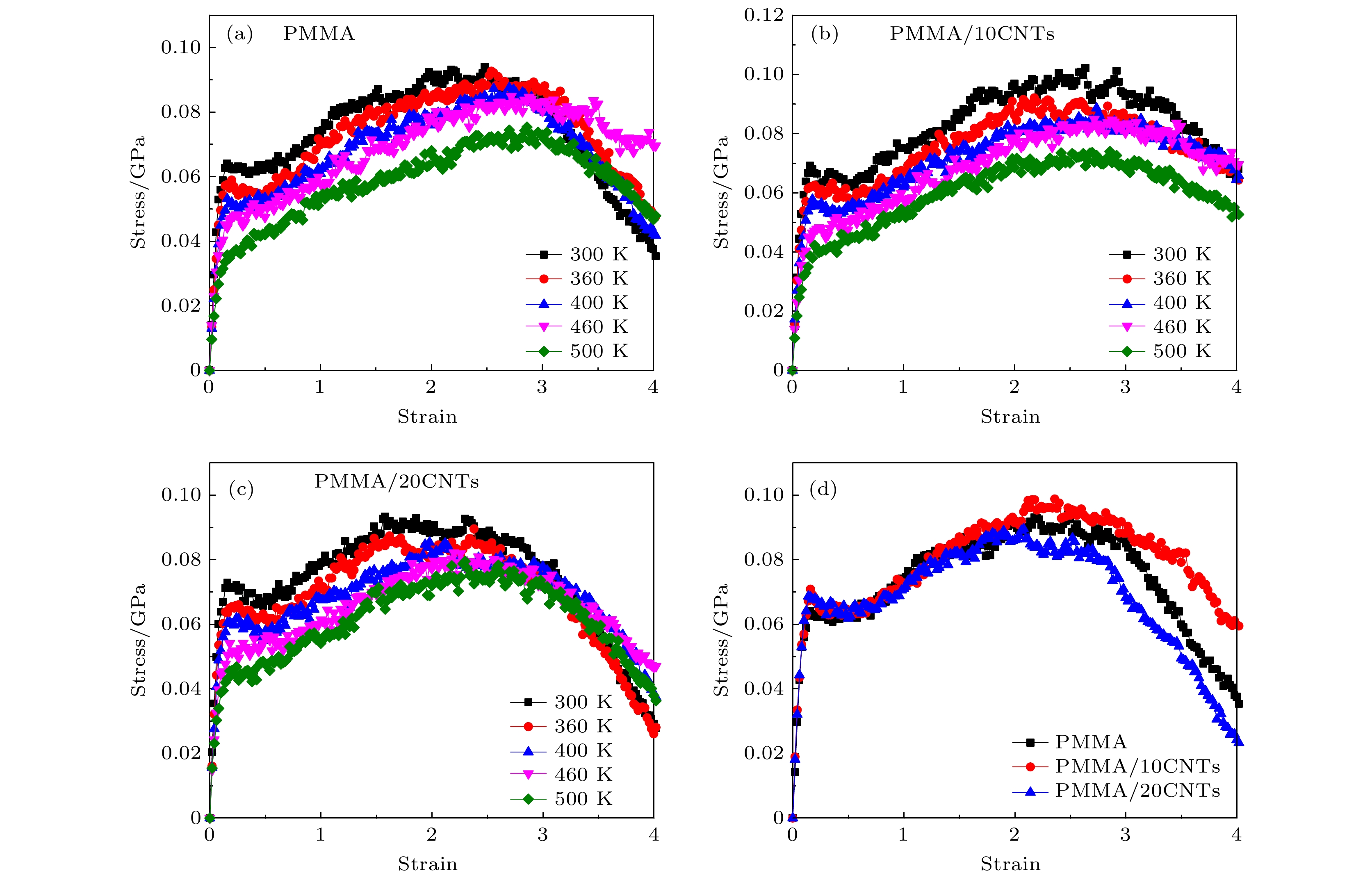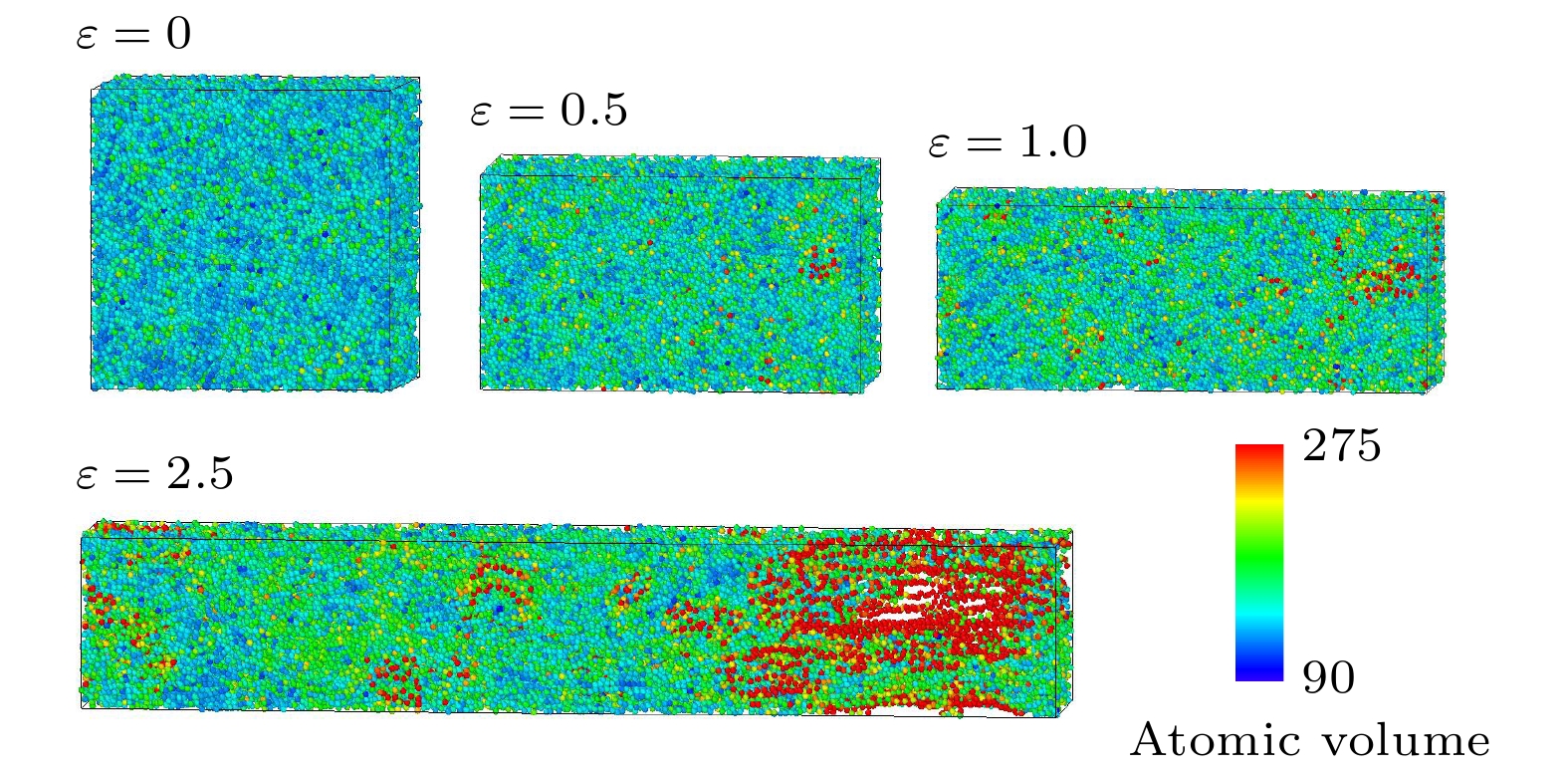-
短纤维结构对聚合物材料玻璃化转变温度及非线性力学具有非常重要的影响. 本文利用粗粒化分子动力学方法研究了碳纳米管(CNTs)含量对聚甲基丙烯酸甲酯(PMMA)玻璃化转变、扩散系数及非线性力学特性的影响. 分子动力学模拟结果显示: 短CNTs纤维的加入的确会改变PMMA体系的玻璃化转变温度, 模拟结果与实验测量结果一致, 而且随着CNTs含量的增加其对应的玻璃化转变温度也会随着增加. 进一步分析扩散特性发现, CNTs加入PMMA对于体系扩散特性的改变主要发生在玻璃化温度以上, 玻璃化温度以下结构对应的扩散系数差异非常的小. 聚合物材料在服役过程中难免要遭受应力-应变的作用, 而且其结构对应的模量和韧性成反比. 基于此, 本文通过非平衡分子动力学探究了短CNTs纤维添加PMMA复合材料的非线性力学特性. 模拟结果显示: 随着CNTs纤维的含量增加, 其对应的屈服模量也在不断的增加, 而且含有短CNTs纤维的体系还能够保持原来的韧性. 因此, 分子层面的理论研究策略可以为进一步的实验和加工提供理论指导.The glass transition temperature and nonlinear mechanics of polymer nanocomposites are strongly influenced by the short fibers. In this paper, coarse-grained molecular dynamics simulations are used to study the effects of single-walled carbon nanotube (CNT) content on the glass transition, diffusion coefficient, viscosity and nonlinear mechanical properties of poly(methyl methacrylate) (PMMA)/CNT nanocomposites. The glass transition temperature Tg is very important for the application of the materials. The Tg is related to the specific volume of the system. Generally, the location of the discontinuity on the curve of specific volume vs. temperature is the position of Tg. Our simulation results show that the Tg of PMMA/CNT composite increases with CNT content, and the result is consistent with the experimental value (434 K). This increase of Tg is evidently due to the presence of CNTs, which imposes a limit on the mobility of the molecules of PMMA. For the free volume in the liquid state, recent experiments pointed out that the molecular mutation is relatively easy to occur because the unoccupied volume is large. Further analysis of the diffusion coefficient of the PMMA/CNT indicates that the difference in diffusion characteristic occurs above the glass transition temperature, and the diffusion coefficient of PMMA system and PMMA/CNT system are the same below the glass transition temperature. Polymer materials in the service process will inevitably suffer the deformation, and the modulus and toughness of material are inversely proportional. Based on this problem, the nonlinear mechanical properties of short CNTs added PMMA composite are studied by nonequilibrium molecular dynamics. Our results show that the yield modulus increases with the CNT content increasing. However, the toughness is almost unchanged. In order to further understand the origin of stress of PMMA/CNT nanocomposites, the stretch ratio and orientation parameters of MPPA chains are also investigated in the present work. According to the stretch ratio and orientation parameters, it is not difficult to conclude that the stress-strain curve is mainly the result of the synergistic effect of molecular chain stretching and orientation. This work provides a theoretical guidance for further experiments and processing at the atomic and molecular level.
-
Keywords:
- glass transition temperature /
- nonlinear mechanics /
- nanocomposites /
- diffusion coefficient
[1] Mackay M E, Dao T T, Tuteja A, Ho D L, van Horn B, Kim H C, Hawker C J 2003 Nat. Mater. 2 762
 Google Scholar
Google Scholar
[2] Polizos G, Tuncer E, Agapov A L, Stevens D, Sokolov A P, Kidder M K, Jacobs J D, Koerner H, Vaia R A, More K L, Sauers I 2012 Polymer 53 595
 Google Scholar
Google Scholar
[3] Mammeri F, Teyssandier J, Connan C, Le Bourhis E, Chehimi M M 2012 RSC Adv. 2 2462
 Google Scholar
Google Scholar
[4] Luo J T, Wen H C, Wu W F, Chou C P 2008 Polym. Compos. 29 1285
 Google Scholar
Google Scholar
[5] De S K 1996 Short Fibre-polymer Composites (Woodhead: Woodhead Publishing) p257
[6] Salami-Kalajahi M, Haddadi-Asl V, Behboodi-Sadabad F, Rahimi-Razin S, Roghani-Mamaqani H 2012 Polym. Compos. 33 215
 Google Scholar
Google Scholar
[7] Van Loock F, Fleck N A 2018 Polymer 148 259
 Google Scholar
Google Scholar
[8] Haggenmueller R, Gommans H H, Rinzler A G, Fischer J E, Winey K I 2000 Chem. Phys. Lett. 330 219
 Google Scholar
Google Scholar
[9] Du F, Fischer J E, Winey K I 2003 J. Polym. Sci. , Part B:Polym. Phys. 41 3333
 Google Scholar
Google Scholar
[10] Wang J F, Yang J P, Tam L h, Zhang W 2021 Mech. Syst. Singal PR 153 107530
 Google Scholar
Google Scholar
[11] 杨俊升, 朱子亮, 曹启龙 2020 物理学报 69 038101
Yang J S, Zhu Z L, Cao Q L 2020 Acta Phys. Sin. 69 038101
[12] 陈超, 段芳莉 2020 物理学报 69 1 93102
 Google Scholar
Google Scholar
Chen C, Duan F L 2020 Acta Phys. Sin. 69 1 93102
 Google Scholar
Google Scholar
[13] Yang J S, Yang C L, Wang M S, Chen B D, Ma X G 2011 Phys. Chem. Chem. Phys. 13 15476
 Google Scholar
Google Scholar
[14] Skountzos E N, Mermigkis P G, Mavrantzas V G 2018 J. Phys. Chem. B 122 9007
 Google Scholar
Google Scholar
[15] Jiang Q, Tallury S S, Qiu Y, Pasquinelli M A 2020 Nanotechnol. Rev. 9 136
 Google Scholar
Google Scholar
[16] Mohammadi M, fazli H, karevan M, Davoodi J 2017 Eur. Polym. J. 91 121
 Google Scholar
Google Scholar
[17] Zhao J, Jiang J W, Wang L, Guo W, Rabczuk T 2014 J. Mech. Phys. Solids 71 197
 Google Scholar
Google Scholar
[18] Arash B, Park H S, Rabczuk T 2015 Compos. Struct. 134 981
 Google Scholar
Google Scholar
[19] Meng Z, Soler-Crespo R A, Xia W, Gao W, Ruiz L, Espinosa H D, Keten S 2017 Carbon 117 476
 Google Scholar
Google Scholar
[20] Mousavi A A, Arash B, Zhuang X, Rabczuk T 2016 Compos. B. Eng. 95 404
 Google Scholar
Google Scholar
[21] Ash B J, Siegel R W, Schadler L S 2004 J. Polym. Sci. , Part B:Polym. Phys. 42 4371
 Google Scholar
Google Scholar
[22] Mohammadi M, Davoodi J, Javanbakht M, Rezaei H 2018 Mater. Res. Express 6 035309
 Google Scholar
Google Scholar
-
表 1 PMMA及PMMA-CNT粗粒化粒子之间相互作用力场参数
Table 1. Parameters of the CG force field for PMMA and CNT beads.
Type of interaction Parameters PMMA CNT PMMA
/CNTBond kd/(kcal·mol–1·Å–2) 97.3 805.15 — d0/Å 4.05 9.45 — Angle kθ/(kcal·mol–1·Å–2) 400 32140 — θ0/(o) 84.6 180 — vdW D0/(kcal·mol–1) 0.56 5.34 1.4 r0/Å 6.53 9.45 7.7 -
[1] Mackay M E, Dao T T, Tuteja A, Ho D L, van Horn B, Kim H C, Hawker C J 2003 Nat. Mater. 2 762
 Google Scholar
Google Scholar
[2] Polizos G, Tuncer E, Agapov A L, Stevens D, Sokolov A P, Kidder M K, Jacobs J D, Koerner H, Vaia R A, More K L, Sauers I 2012 Polymer 53 595
 Google Scholar
Google Scholar
[3] Mammeri F, Teyssandier J, Connan C, Le Bourhis E, Chehimi M M 2012 RSC Adv. 2 2462
 Google Scholar
Google Scholar
[4] Luo J T, Wen H C, Wu W F, Chou C P 2008 Polym. Compos. 29 1285
 Google Scholar
Google Scholar
[5] De S K 1996 Short Fibre-polymer Composites (Woodhead: Woodhead Publishing) p257
[6] Salami-Kalajahi M, Haddadi-Asl V, Behboodi-Sadabad F, Rahimi-Razin S, Roghani-Mamaqani H 2012 Polym. Compos. 33 215
 Google Scholar
Google Scholar
[7] Van Loock F, Fleck N A 2018 Polymer 148 259
 Google Scholar
Google Scholar
[8] Haggenmueller R, Gommans H H, Rinzler A G, Fischer J E, Winey K I 2000 Chem. Phys. Lett. 330 219
 Google Scholar
Google Scholar
[9] Du F, Fischer J E, Winey K I 2003 J. Polym. Sci. , Part B:Polym. Phys. 41 3333
 Google Scholar
Google Scholar
[10] Wang J F, Yang J P, Tam L h, Zhang W 2021 Mech. Syst. Singal PR 153 107530
 Google Scholar
Google Scholar
[11] 杨俊升, 朱子亮, 曹启龙 2020 物理学报 69 038101
Yang J S, Zhu Z L, Cao Q L 2020 Acta Phys. Sin. 69 038101
[12] 陈超, 段芳莉 2020 物理学报 69 1 93102
 Google Scholar
Google Scholar
Chen C, Duan F L 2020 Acta Phys. Sin. 69 1 93102
 Google Scholar
Google Scholar
[13] Yang J S, Yang C L, Wang M S, Chen B D, Ma X G 2011 Phys. Chem. Chem. Phys. 13 15476
 Google Scholar
Google Scholar
[14] Skountzos E N, Mermigkis P G, Mavrantzas V G 2018 J. Phys. Chem. B 122 9007
 Google Scholar
Google Scholar
[15] Jiang Q, Tallury S S, Qiu Y, Pasquinelli M A 2020 Nanotechnol. Rev. 9 136
 Google Scholar
Google Scholar
[16] Mohammadi M, fazli H, karevan M, Davoodi J 2017 Eur. Polym. J. 91 121
 Google Scholar
Google Scholar
[17] Zhao J, Jiang J W, Wang L, Guo W, Rabczuk T 2014 J. Mech. Phys. Solids 71 197
 Google Scholar
Google Scholar
[18] Arash B, Park H S, Rabczuk T 2015 Compos. Struct. 134 981
 Google Scholar
Google Scholar
[19] Meng Z, Soler-Crespo R A, Xia W, Gao W, Ruiz L, Espinosa H D, Keten S 2017 Carbon 117 476
 Google Scholar
Google Scholar
[20] Mousavi A A, Arash B, Zhuang X, Rabczuk T 2016 Compos. B. Eng. 95 404
 Google Scholar
Google Scholar
[21] Ash B J, Siegel R W, Schadler L S 2004 J. Polym. Sci. , Part B:Polym. Phys. 42 4371
 Google Scholar
Google Scholar
[22] Mohammadi M, Davoodi J, Javanbakht M, Rezaei H 2018 Mater. Res. Express 6 035309
 Google Scholar
Google Scholar
计量
- 文章访问数: 8176
- PDF下载量: 109
- 被引次数: 0














 下载:
下载:







